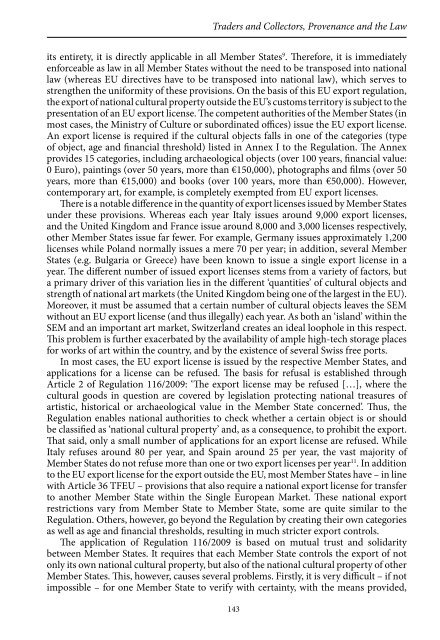Countering
Book_observatory_illicit_traffic_version%20issuu
Book_observatory_illicit_traffic_version%20issuu
You also want an ePaper? Increase the reach of your titles
YUMPU automatically turns print PDFs into web optimized ePapers that Google loves.
Robert Peters<br />
and within reasonable time for the applicant of an EU export license, whether a certain<br />
painting, book or manuscript belongs to the national cultural property of one of the<br />
other EU Member States. Secondly, the 15 categories of the Annex of the Regulation<br />
are rather ambiguous. This has caused, in practice, difficulty in the correct application<br />
and interpretation of the categories, in particular with regard to coins and single<br />
paleontological items, which do not fit properly in the categories given. Thirdly, for<br />
comprehensible reasons of manageability in all Member States, the Regulation provides<br />
only a rough ‘filter’ for national cultural property on the basis of age and financial<br />
thresholds. Most States do not designate their cultural national property on the basis<br />
of monetary value. Thus, it is not surprising that the thresholds have been criticized of<br />
being too high, particularly by new EU Member States. The art market, on the other side,<br />
has repeatedly criticized the thresholds of being too low.<br />
Single European Market (SEM) and the return of unlawfully removed cultural<br />
property between Member States<br />
With the creation of the SEM and the abolition of national customs controls, the EU<br />
adopted an additional legal instrument in 1993. Directive 93/7/EEC of 15 March 1993<br />
on the return of cultural objects unlawfully removed from the territory of a Member<br />
State complements the EU Export Regulation, in order to reconcile the fundamental<br />
principle of the free movement of goods with the protection of national cultural property<br />
set out in Article 36 TFEU 12 . Unlike the UNESCO 1970 Convention, this Directive is<br />
not in itself an instrument against trafficking in cultural property. Rather, it primarily<br />
compensates for the abolition of the national customs controls among Member States by<br />
discouraging illegal export within the Single Market. It does so by creating the obligation<br />
to return unlawfully removed cultural property. Unlike EU regulations, EU directives<br />
are not directly applicable. Therefore, directives require national implementation by<br />
each Member State before they take effect. Whereas Regulation 116/2009 requires<br />
a uniform EU export standard (all Member States issue the same EU export license),<br />
the Directive sets minimal standards allowing Member States to adopt higher (but not<br />
lower) standards in their national laws transposing the directive. By using a directive<br />
rather than a regulation as the legal instrument, the EU aims at establishing harmonized<br />
minimal standards, while still allowing Member States the flexibility to set higher ones,<br />
if deemed appropriate by the respective national parliament.<br />
Directive 93/7/EEC on the return of unlawfully removed cultural property<br />
provides for administrative cooperation, in order to facilitate the return of cultural<br />
property. Therefore, Member States have several obligations under the Directive, such<br />
as appointing one or more central authorities to assist and cooperate with the other<br />
Member States. The obligation to return, however, does not apply to the Member State,<br />
but rather to the private individual – namely, the ‘possessor’ (if not, then the ‘holder’)<br />
of the cultural object in question. Consequently, the requesting Member State must<br />
initiate legal proceedings before the competent court in another Member State against<br />
the possessor, if negotiations and out-of-court settlement fail. The requesting Member<br />
State must demonstrate that the cultural object belongs to its national cultural property<br />
and was unlawfully removed from its territory after 1 January 1993. If it fails to do so, the<br />
legislation does not provide a legal obligation for the object to be returned. Moreover,<br />
the scope of the 1993 Directive is restricted to cultural objects listed in the Annex to the<br />
Directive. This means that a certain cultural object, although protected by national law<br />
144


